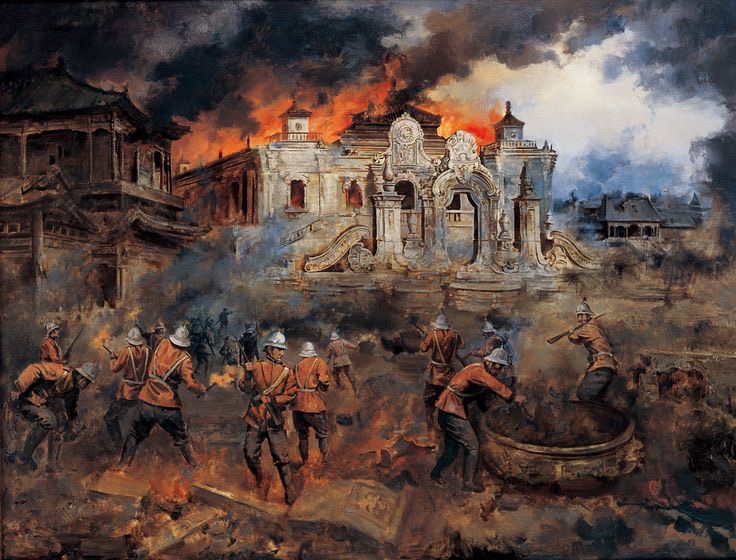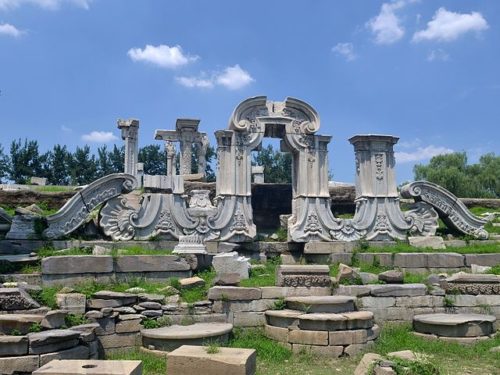This Week in China’s History: October 18, 1860
The Opium War that ended in 1842 created a treaty regime that framed China’s “century of humiliation”: treaty ports, foreign concessions, extraterritoriality, and colonialism. Unsurprisingly for such a sea change, the new circumstances were resisted. Along the southeast coast, especially, Qing and foreign interpretations of the treaties differed. British authorities felt they were entitled to settlement in the city of Guangzhou; the Qing thought the terms of the treaty gave foreigners much more limited rights. And opium, though it came to define the war, was unmentioned in the Treaty of Nanjing, leaving trade in the narcotic still unresolved. For more than a decade, frustration mounted until, in 1856, the British used the seizure of a pirate ship near Hong Kong to launch a new war, one that was settled with a Treaty of Tianjin, signed in 1858.
But the settlement did not settle things. The Qing court was deeply divided between those who advocated aggressive resistance to the British and those in favor of peace. Although the “doves” had prevailed in negotiating a treaty, more hawkish elements prevailed upon the emperor to resist the implementation of the treaty, which included the opening of new ports, the establishment of permanent diplomatic missions in Beijing, and the right of foreigners to travel freely throughout China. Determined to enforce the treaty, Britain and France reignited the war and headed north, contradicting Qing insistence that any negotiations be carried out in Guangzhou. A first attack ended disastrously for the Europeans, but in 1860, a joint expeditionary force of 18,000 French and British troops marched on Beijing.
When they got there, they embarked on days of looting and destruction that redefined European imperialism in China.
Historian Robert Bickers, in his sweeping history, The Scramble for China, described the European advance as “bouts of negotiation interspersed with bloody clashes.” Armed with deadlier rifles than ever before, the foreign army reached the walls of the capital in the first week of October, where it laid waste to a column of Mongol cavalry and celebrated by looting both the Old (Yuánmíngyuán 圆明园) and New (颐和园 Yíhéyuán) Summer Palaces. Treasures flowed out of the Summer Palace, many disappearing into the auction houses, wealthy estates, and museum collections of Europe. Symbolic of the plunder was a Pekinese dog named “Looty” — in the spirit of “saying the quiet part out loud” — which has become a standard illustration for Chinese history lectures in the age of PowerPoint, swiped from the imperial kennel and transferred from one dynasty to another. Besides Looty, the most famous booty from the site may be 12 zodiac sculptures, which Jackie Chan has made his personal mission to recover (Chan also directed and starred in a fictional movie about the quest, Chinese Zodiac).
The conflict decided, a series of diplomatic conventions were signed, affirming the 1858 treaties and adding some new concessions for good measure.
But this was, once again, an incomplete conclusion.
The previous month, in September, as the European Expeditionary Force moved toward Beijing, a party of British and French diplomats, officers, and journalists had been taken prisoner by the Qing. Among the dozen or so men was Thomas William Bowlby, a Times correspondent, and Harry Parkes, a long-time British diplomat who had most recently served as the British consul in Guangzhou. Whether in retaliation for British incursions, frustration over the decline of Qing power, or the brutality that is inescapable in war, the Qing authorities not only detained the British but tortured them as well, binding their limbs with wet rope so that, as the ropes dried, they cut into the flesh, denying food and water, and filling their mouths with dirt. Bowlby — whose diaries came to light in 2019 — was among several who died from their ordeal.
The fate of these men was unknown to their compatriots until mid-October, when Parkes and several others were released (hours ahead of an imperial order to execute them). As Parkes relayed the story of their month-long predicament, outrage swept through the European ranks, and their commanders determined that revenge was called for.
The Europeans determined that it was the emperor himself who was most responsible, and so sought vengeance that would affect the monarch personally. The commander of the British forces, Lord Elgin — whose father had infamously plundered the Parthenon friezes from Athens — selected the Old Summer Palace for destruction.
“Old Summer Palace” is an odd name for the complex known in Chinese as Yuanmingyuan, or the Garden of Eternal Brightness. It was not a single palace, as the English name implies, but a vast garden of 850 acres, with more than 600 different structures built for the pleasure of the emperor himself. Begun in 1707, the garden eventually came to encompass 40 “scenes” that the emperors — Kangxi, Yongzheng, and Qianlong — chose for their pleasure. These scenes were living tableaux, mimicking the famed gardens of Hangzhou and Suzhou, the temples of Mongolia and Tibet, and scenic spots from across China and beyond. A street scene — complete with staff playing shopkeepers, beggars, and entertainers — was maintained so the emperor could stroll down it as he pleased. (If you can’t get on one of his tours of the Yuanmingyuan in Beijing, give a listen to historian Jeremiah Jenne’s description of the Old Summer Palace.)
From the European perspective, the most impressive portion of the Yuanmingyuan was the Xiyang lou, or Western buildings. This complex, designed and constructed by European Jesuits in the 1740s at the behest of the Qianlong emperor, featured baroque palaces, formal gardens, and elaborate monuments modeled on the finest of European architecture.
British troops — the French, who had favored targeting the Forbidden City rather than Yuanmingyuan, sat out — started setting fires on October 18, but it took two days to raze the complex. Because the Chinese structures were made of wood, they were all but completely destroyed in the blaze. The stone European-styled buildings of the Xiyang lou left behind more relics. Many of the stones were carted off by locals for use in buildings, but enough was left to recall at least a piece of the grandeur that had been lost.
The relics of the Yuanmingyuan — mainly the masonry of the Xiyang lou — have been left largely unrestored, arranged on their original site. Now a public park, the Yuanmingyuan is a place where the people of Beijing can enjoy quiet while also reflecting on their nation’s history.
It is this last role — as an historical site — that makes the Yuanmingyuan especially relevant this month, as Xí Jìnpíng 习近平 moves toward confirmation of an unprecedented third term as Communist Party General Secretary. One of Xi’s first speeches upon coming to power, in 2012, hearkened back to the Opium War and emphasized that since that time, only one entity — the Chinese Communist Party — has managed to successfully stand up to foreign aggression and restore China’s status as a great power, something it had not enjoyed since the high Qing era. That nationalist narrative is fundamental to party legitimacy today, and helps explain why the ashes of the Yuanmingyuan are kept warm, in case the flames of nationalism need to be fanned.
This Week in China’s History is a weekly column.







